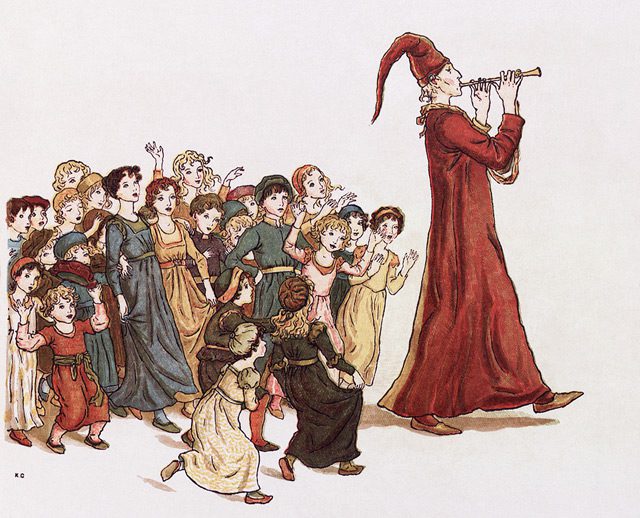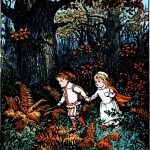
On a summer’s day in 1284, in the small town of Hamelin in what is now northern Germany, a chilling event unfolded that would echo through the centuries. According to legend, 130 children disappeared, led away by a mysterious figure known as the Pied Piper, whose enchanting flute lured them to an uncertain fate. What truly happened to those children remains unknown, but the story has grown from a tragic historical note into one of the most famous legends of all time. Blending history and folklore, this tale has inspired artists for centuries, becoming a vibrant part of visual, literary, and performing arts.
This is the story of how a dark mystery, rooted in history, transformed into a timeless muse for creativity—and how art has immortalized the eerie allure of the Pied Piper’s melody.
The Historical Roots of the Pied Piper Legend
The legend of the Pied Piper is unique because it straddles the line between recorded history and myth. It begins with a single puzzling event: the disappearance of 130 children from the town of Hamelin. Unlike many folk tales, which originate purely from oral tradition, this story has a traceable historical anchor. A chronicle from the 15th century records, without explanation:
“In the year 1284, on the day of Saints John and Paul, 130 children of Hamelin left the town by following a piper dressed in multicolored clothes to Calvary near the Koppen, where they were lost.”
What could have caused such a disappearance? There are no surviving accounts from the time of the event, only vague hints in later records. No mention of rats, no hint of magic—just the stark fact that the children vanished.
Over the centuries, historians and folklorists have pieced together theories, but none can definitively explain the mystery. Some believe the children joined a mass migration, following recruiters who offered the promise of new land in Eastern Europe. During this period, German settlers were invited to colonize regions in modern-day Poland, Romania, and Hungary. The Pied Piper, then, might have been a charismatic recruiter who lured the town’s youth away.
Others suggest a darker fate: perhaps the children succumbed to disease, symbolized by the Piper as a grim reaper-like figure. Plagues were common in medieval Europe, and legends often transformed catastrophic events into metaphors. Alternatively, some scholars link the tale to the Children’s Crusade, a historical event where large groups of children set off for the Holy Land, many of whom never returned. Other theories include a natural disaster, such as a landslide, or even ritual sacrifice, hinted at in some darker retellings.
What makes this tale so compelling is the lack of answers. The ambiguity of the event has allowed the story to evolve, gaining layers of symbolism and imagination over the centuries. This unresolved mystery has captured the imagination of artists, giving them a rich tapestry of possibilities to explore.
The Pied Piper in Visual Arts
Throughout history, artists have turned to the Pied Piper as a source of inspiration, fascinated by the story’s strange mix of charm and horror. From early depictions in medieval churches to modern abstract interpretations, the Piper has been transformed into an enduring symbol of art’s power to enchant—and its potential to deceive.
Medieval Beginnings: Stained Glass and Folklore
One of the earliest artistic depictions of the Pied Piper was a stained-glass window in Hamelin’s church, created around 1300 to commemorate the event. Although the window was destroyed in later centuries, descriptions survive, detailing a vivid portrayal of the Piper leading children away. This artwork likely served as both a historical marker and a moral warning, preserving the memory of the lost children while embedding the story into the town’s culture.
Medieval artists often used the Pied Piper as a symbol of broken promises or divine retribution. Woodcuts and tapestries from the 15th and 16th centuries began to incorporate more fantastical elements, including the rats that now dominate the story. These early works depicted the Piper as a larger-than-life figure, emphasizing his role as both savior and avenger.
The Renaissance and Moral Symbolism
During the Renaissance, artists elevated the Pied Piper from a local legend to a universal allegory. Paintings and illustrations portrayed him as a metaphor for the dangers of greed, pride, and betrayal. The Piper’s brightly colored clothing and flute became iconic, representing the dual nature of his character: a bringer of beauty and destruction.
Victorian Revival: Illustration as Storytelling
The Victorian era saw a resurgence of interest in folklore, and the Pied Piper became a popular subject for writers and illustrators. Robert Browning’s 1842 poem retold the story with a dramatic flair that captured the public’s imagination. Artists like Arthur Rackham and Kate Greenaway brought the Piper to life with illustrations that combined whimsy and menace. Rackham’s gothic, shadowy style portrayed the Piper as an almost demonic figure, while Greenaway’s softer, pastoral scenes emphasized the innocence of the children.
These works not only preserved the story for new audiences but also added layers of interpretation, reflecting the cultural values of their time. In Victorian England, the tale served as both a cautionary tale for children and a critique of societal failures, such as broken promises and exploitative leadership.
Modern and Contemporary Art: The Piper Reimagined
In the 20th and 21st centuries, the Pied Piper has continued to inspire artists across genres. Public art installations, such as the bronze Pied Piper statue in Hamelin, celebrate the town’s connection to the legend while inviting new interpretations. Murals in urban settings reimagine the story for modern audiences, sometimes casting the Piper as a political figure or social disruptor.
Contemporary artists have also embraced abstraction, using the Piper as a metaphor for themes like manipulation, mass migration, and the loss of innocence. By moving beyond literal representations, these works challenge viewers to consider the deeper implications of the story, ensuring its relevance in an ever-changing world.
The Pied Piper in Performing Arts
The Pied Piper legend, with its inherent drama and musicality, has found a natural home in the performing arts. From operas and ballets to theatrical productions, the Piper’s story comes alive on stage, offering audiences a visceral experience of its enchantment and tragedy.
The Music of the Piper
Music is at the heart of the Pied Piper legend. His flute, both a symbol of beauty and a tool of deception, has inspired composers to create haunting melodies that capture the story’s eerie charm. Classical works, such as Jules Massenet’s operatic compositions, evoke the Piper’s hypnotic power, blending ethereal tones with dark undertones that hint at the story’s sinister conclusion.
In modern times, experimental composers have embraced the legend, creating soundscapes that combine traditional instruments with electronic effects to replicate the Piper’s haunting tune. These works immerse audiences in the story’s atmosphere, making them feel the pull of the Piper’s music.
Theater and Ballet: A Visual and Emotional Feast
Theater productions often focus on the moral and psychological aspects of the Pied Piper legend. Minimalist stagings emphasize the story’s timeless themes—broken trust, manipulation, and loss—while elaborate productions bring the Piper’s world to life with vivid costumes and sets.
Ballet, meanwhile, uses the grace of movement to tell the story without words. Choreographers explore the tension between the Piper’s alluring charm and the tragedy he leaves in his wake, creating performances that are as haunting as they are beautiful.
Hamelin: A Town Transformed by Art
In Hamelin, the Pied Piper is more than just a story—it is a cultural identity. The town has embraced the legend, transforming it into a living tradition that draws visitors from around the world.
A Canvas of Art and History
Walking through Hamelin, visitors encounter a town steeped in the Piper’s legacy. Murals, statues, and historical markers tell the story at every turn. The Pied Piper House, with its ornate façade, stands as a testament to the town’s connection to the legend, offering exhibitions that blend history and art.
Hamelin’s artistic homage extends beyond visual art. Each summer, the town hosts theatrical reenactments of the Pied Piper story, with actors in colorful costumes recreating key moments from the legend. These performances bring the story to life, connecting the town’s past to its present in a way that is both entertaining and deeply meaningful.
Art as a Medium for Memory and Mystery
The Pied Piper legend endures because it is more than just a story—it is a question. Who was the Piper? What happened to the children? These unanswered mysteries invite interpretation, making the tale a fertile ground for artistic exploration.
How Art Keeps the Legend Alive
From medieval stained glass to contemporary murals, artists have used the Pied Piper as a lens to explore universal themes. Each work of art adds to the story, keeping it relevant for new generations while preserving its timeless allure.
Provoking Reflection Through Ambiguity
The beauty of the Pied Piper legend lies in its ambiguity. It is a story about music and betrayal, innocence and loss, power and vulnerability. By embracing this complexity, artists challenge audiences to reflect on their own experiences, ensuring that the Pied Piper’s melody will never truly fade.
Key Takeaways
The Pied Piper of Hamelin is a story that has grown far beyond its historical origins. Through art, music, theater, and community storytelling, this legend continues to captivate the world, proving that the most powerful stories are those that leave us with more questions than answers.




